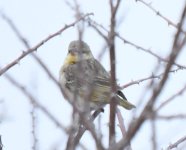L'argonnais
Well-known member

Hello,
bird seen last month in Namibia , "closed" to Etosha ; 30 km south of Anderson Gate (Gate of the middle of the park)
I have spent maybe one hour (or still more ! ) , searching on the internet without any success which bird is on the picture of the crop. I expected it to be a Weaber or a canary ; did not find a picture like my bird.
I also checked all the possible bird of the region, even Namibia - no success neither !
and in fact , on the original picture , there are 3 Red-billed Quelea ; then I wonder if it is the same specy or not???? for me no; but I do not see any other ; and of course, I do not know that species. So maybe????
JR
bird seen last month in Namibia , "closed" to Etosha ; 30 km south of Anderson Gate (Gate of the middle of the park)
I have spent maybe one hour (or still more ! ) , searching on the internet without any success which bird is on the picture of the crop. I expected it to be a Weaber or a canary ; did not find a picture like my bird.
I also checked all the possible bird of the region, even Namibia - no success neither !
and in fact , on the original picture , there are 3 Red-billed Quelea ; then I wonder if it is the same specy or not???? for me no; but I do not see any other ; and of course, I do not know that species. So maybe????
JR






